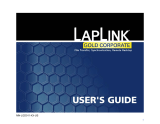23
MODULAR SMART SWITCH
MODE COM1:9600,N,8,1,P <enter>
This sets the baud to 9600, no parity, 8 bits per character, and 1 stop bit on
COM1. You may wish to put this in your computer’s AUTOEXEC.BAT file.
You may wish to use the supplied software to enhance the speed and
functionality of your serial port (refer to Chapter 7 for full details on the
benefits of using the software utility).
ADMODE COM1:57600,N,8,1 <enter>
If you have more than one port on your PC, make sure that your printout is
sent to a port that is connected to the Modular Smart Switch. For IBM
compatible PCs, DOS will prompt you to specify the printer port the first time
you issue a print command. If you are using a parallel port (LPT1, LPT2, or
LPT3), you can print directly without any further setup. If you are normally
using a serial port to output print data, you may wish to redirect the parallel
port data to output on the serial port, using the MODE command. The
following example will set your PC to send all LPT1 data to COM1.
MODE LPT1:=COM1:
If you are going to plot/print from DOS, make sure that the computer
cannot timeout if the buffer on the Modular Smart Switch becomes full. This
could cause errors on your plots or an error message to be displayed on your
screen. To avoid this, make sure that you have issued a MODE command with
the P option set. If you wish to run your serial port at a high baud rate and
make sure that no computer times out, you can use the MODE and ADMODE
commands together. The ADMODE protocol will always override the MODE
protocol. The following example would set COM1 to 57600 baud, no parity,
8 bits, 1 stop bit, and no application timeout.
MODE COM1:9600,N,8,1,P <enter>
ADMODE COM1:57600,N,8,1 <enter>
NOTE
If you are sending plot/print data from IBM compatibles using a serial
port, make sure that your AUTOEXEC.BAT includes both the MODE (with
P option) and ADMODE commands relevant to that port.
22
MODULAR SMART SWITCH
Plug in your cables, making sure that you are using the correct type of cable
(see Appendixes A and B) and that you are connecting to the right type of
port.
CAUTION
Connecting to the wrong type of port could damage both the Modular
Smart Switch and your computers and printers.
5.5 Switching On
Plug the power supply lead into the rear of the Modular Smart Switch. Plug
the power lead into a suitable supply socket. Switch on at the supply. Switch
on the Modular Smart Switch using the switch at the rear.
The Power indicator (green) should come on and stay on. The Buffer
Status indicators (red) should flicker for a few seconds while the unit self-
tests, and then go out.
It is generally better to switch on all your devices together or switch on the
Modular Smart Switch last.
5.6 Enabling Computers
Computers Connected to Parallel Ports
Parallel interfaces do not normally need to be configured. For IBM PCs
running DOS, make sure that PC timeouts do not occur if the Modular Smart
Switch’s buffer becomes full. This can be done using the MODE command
as follows. Refer to your DOS manual for details.
MODE LPT1: , , P
Computers Connected to Serial Ports
Each computer must communicate with the Modular Smart Switch in the
format expected by the port it is connected to. The baud rate, parity, bits per
character, stop bits, and handshake format must be the same on the
computer and the Modular Smart Switch port. Your computer instruction
manual will tell you how to set up these parameters.
For IBM PCs and compatibles, the MODE command is used to select the
correct parameters. With the default option-switch settings and output on
COM1, the MODE command is:
























